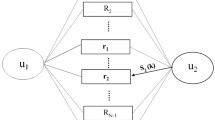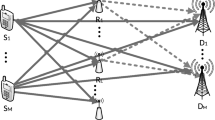Abstract
In this paper, the relay selection problem for two-way relaying networks in single and dual relay selection schemes is addressed. In the single relay selection scheme, the problem is to find the best relay node which leads to the minimum bit error rate (BER) between the source nodes. We then derive the upper and lower bounds for the signal to noise ratio and the end-to-end BER of this scheme. In the dual relay selection scheme, the problem is to find the two best relay nodes. In this scheme, Alamouti space-time coding and physical layer network coding are utilized in order to achieve the higher performance. For improving the system performance, optimal power allocation between the sources and the relays is considered based on decreasing the BER. Finally, simulation results are provided to verify the correctness of analytical results.









Similar content being viewed by others
References
Sendonaris, A., Erkip, E., & Aazhang, B. (2003). User cooperation diversity. Part I: System description. IEEE Transactions on Communications, 51(11), 1927–1938.
Sendonaris, A., Erkip, E., & Aazhang, B. (2003). User cooperation diversity. Part II: Implementation aspects and performance analysis. IEEE Transactions on Communications, 51(11), 1939–1948.
Laneman, J., Tse, D., & Wornell, G. (2004). Cooperative diversity in wireless networks: Efficient protocols and outage behavior. IEEE Transactions on Information Theory, 50(12), 3062–3080.
Dohler, M., & Li, Y. (2010). Cooperative communications hardware, channel, PHY. New York: Wiley.
Soleimani-Nasab, E., Kalantari, A. & Ardebilipour, M. (2011). Performance analysis of selective DF relay networks over Rician fading channels. In Proceedings of 2011 IEEE symposium on computers and communications (ISCC), pp. 117–122.
Soleimani-Nasab, E., Kalantari, A., & Ardebilipour, M. (2011). Performance analysis of multi-antenna DF relay networks over Nakagami-\(m\) fading channels. IEEE Communications Letters, 15(12), 1372–1374.
Kalantari, A., Soleimani-Nasab, E., & Ardebilipour, M. (2011). Performance analysis of best selection DF relay networks over Nakagami-\(n\) fading channels. In Proceedings of 19th Iranian conference on electrical engineering (ICEE).
Soleimani-Nasab, E., Ardebilipour, M., & Kalantari, A. (2014). Performance analysis of selective combining decode-and-forward relay networks over Nakagami-\(n\) and Nakagami-\(q\) fading channels. Wireless Communnications and Mobile Computing, 14(16), 1564–1581.
Soleimani-Nasab, E., Ardebilipour, M., Kalantari, A., & Mahboobi, B. (2013). Performance analysis of multi-antenna relay networks with imperfect channel estimation. AEU-International Journal on Electronics and Communications, 67(1), 45–57.
Soleimani-Nasab, E., Matthaiou, M., Ardebilipour, M., & Karagiannidis, G. K. (2013). Two-way AF relaying in the presence of co-channel interference. IEEE Transactions on Communications, 61(8), 3156–3169.
Soleimani-Nasab, E., Matthaiou, M., & Ardebilipour, M. (2013). Multi-relay MIMO systems with OSTBC over Nakagami-\(m\) fading channels. IEEE Transactions on Vehicular Technology, 62(8), 3721–3736.
Soleimani-Nasab, E., Matthaiou, M., Karagiannidis, G. K., & Ardebilipour, M. (2013). Two-way interference-limited AF relaying over Nakagami-\(m\) fading channels. In Proceedings of 2013 IEEE global communications conference (GLOBECOM), pp. 4380–4386.
Soleimani-Nasab, E., Matthaiou, M., & Karagiannidis, G. K. (2013). Two-way interference-limited AF relaying with selection combining. In Proceedings of 2013 IEEE international conference on acoustics, speech and signal processing (ICASSP), pp. 4992–4996.
Soleimani-Nasab, E., Matthaiou, M., & Ardebilipour, M. (2013). On the performance of multi-antenna AF relaying systems over Nakagami-\(m\) fading channels. In Proceedings of 2013 IEEE international conference on communications (ICC), pp. 3041–3046.
Bletsas, A., Khisti, A., Reed, D. P., & Lippman, A. (2006). A simple cooperative diversity method based on network path selection. IEEE Journal on Selected Areas in Communications, 24(3), 659–672.
Zhao, Y., Adve, R. S., & Lim, T. J. (2007). Improving amplify-and-forward relay networks: optimal power allocation versus selection. IEEE Transactions on Wireless Communications, 6(8), 3114–3123.
Bletsas, A., Shin, H., & Win, M. (2007). Outage optimality of opportunistic amplify-and-forward relaying. IEEE Communications Letters, 11(3), 261–263.
Rankov, B., & Wittneben, A. (2007). Spectral efficient protocols for half-duplex fading relay channels. IEEE Journal on Selected Areas in Communications, 25(2), 379–389.
Alshwede, R., Cai, N., Li, R., & Yeung, R. W. (2000). Network information flow. IEEE Transactions on Information Theory, 46(4), 1204–1216.
Zhang, S., Liew, S. C. & Lam, P. P. (2006). Hot topic: physical-layer network coding. In Proceedings of 12th annual international conference on mobile computing and networking (MOBICOM), pp. 358–365.
Ding, Z., Leung, K. K., Goeckel, D. L., & Towsley, D. (2009). On the study of network coding with diversity. IEEE Transaction on Wireless Communications, 8(3), 1247–1259.
Sadek, A. K., Su, W., & Liu, K. J. R. (2007). Multinode cooperative communications in wireless networks. IEEE Transactions on Signal Processing, 55(1), 341–355.
Su, W., Sadek, A. K. & Liu, K. J. R. (2005). SER performance analysis and optimum power allocation for decode-and-forward cooperation protocol in wireless networks. In Proceedings of 2005 IEEE wireless communications and networking conference (WCNC), pp. 984–989.
Li, Y., Louie, R. H. Y., & Vucetic, B. (2010). Relay selection with network coding in two-way relay channels. IEEE Transactions on Vehicular Technology, 59(9), 4489–4499.
Song, L. (2011). Relay selection for two-way relaying with amplify-and-forward protocols. IEEE Transactions on Vehicular Technology, 60(4), 1954–1959.
Nguyen, H. X., & Nguyen, H. N. (2011). Diversity analysis of relay selection schemes for two-way wireless relay networks. Wireless Personal Communications, 59(2), 173–189.
Wang, Z., & Giannakis, G. B. (2003). Simple and general parameterization quantifying performance in fading channels. IEEE Transactions on Communications, 51(8), 1389–1398.
Gradshteyn, I. S., & Ryzhik, I. M. (2007). Table of integrals, series and products (7th ed.). Waltham: Academic Press.
Zheng, L., & Tse, D. N. C. (2003). Diversity and multiplexing: A fundamental tradeoff in multiple-antenna channels. IEEE Transactions on Information Theory, 49(5), 1073–1096.
Yancheng, J., Ge, J., Li, J., & Fang, J. (2010). Design and performance analysis of a space-time cooperative physical-layer network coding scheme. In Proceedings of 2010 international conference on computer application and system modeling (ICCASM), pp. 300–304.
Author information
Authors and Affiliations
Corresponding author
Rights and permissions
About this article
Cite this article
Razmi, N., Attari, M.A., Soleimani-Nasab, E. et al. Single and Dual Relay Selection in Two-Way Network-coded Relay Networks. Wireless Pers Commun 83, 99–115 (2015). https://doi.org/10.1007/s11277-015-2382-6
Published:
Issue Date:
DOI: https://doi.org/10.1007/s11277-015-2382-6




